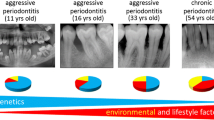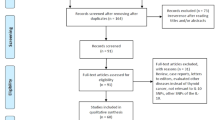Abstract
Objectives
The aim of this study is to investigate the potential role of ANRIL polymorphisms in susceptibility to periodontitis.
Methods
The authors searched Pubmed, Web of Science, and Scopus up to April 2021 to identify all published studies without any language restriction on the association between ANRIL and periodontitis. A meta-analysis of all ANRIL variants replicated by three or more studies was performed by testing multiple genetic models of association. Pooled odds ratios and 95% confidence intervals (CI) were used to estimate associations. Tests for sensitivity and publication bias were performed.
Results
Twenty-two variants in the ANRIL gene were examined for their potential association with the risk of periodontitis. However, only 4 (rs1333048, rs1333042, rs2891168, rs496892) are replicated at least three or more studies. The ANRIL rs1333048 was the most replicated polymorphisms with five articles, seven different populations comprising of 1331 cases, and 2624 controls. The pooled overall analysis showed that rs1333048, rs1333042, rs2891168, and rs496892 polymorphisms were associated with susceptibility to periodontitis in the whole population in allele contrast and dominant models. Moreover, similar to the overall analysis, rs1333048 polymorphism showed a significant association with grade C periodontitis (known as aggressive periodontitis in 1999 classification) in allele contrast (OR = 1.16) and dominant models (1.19). Interestingly, subgroup analysis also showed rs1333048 polymorphism might influence predisposition to a slowly progressive form of periodontitis (known as chronic periodontitis in 1999 classification).
Conclusion
Our findings suggest that the ANRIL rs1333048, rs1333042, rs2891168, and rs496892 polymorphisms might influence predisposition to periodontitis, particularly in Caucasians.
Clinical significance
ANRIL gene may represent a potential risk marker for periodontitis.





Similar content being viewed by others
References
Nibali L, Bayliss-Chapman J, Almofareh S, Zhou Y, Divaris KVieira A (2019) What is the heritability of periodontitis? A systematic review. J Dent Res 98:632–641
Loos BG, van Dyke TE (2000) The role of inflammation and genetics in periodontal disease. Periodontol 2020(83):26–39
Haffajee AD, Socransky SS (1994) Microbial etiological agents of destructive periodontal diseases. Periodontol 2000(5):78–111
Shaddox LM, Morford LA, Nibali L (2000) Periodontal health and disease: the contribution of genetics. Periodontol 2021(85):161–181
Morelli T, Agler CS, Divaris K (2000) Genomics of periodontal disease and tooth morbidity. Periodontol 2020(82):143–156
Nunn ME (2003) Understanding the etiology of periodontitis: an overview of periodontal risk factors. Periodontol 2000(32):11–23
Albandar JM (2002) Global risk factors and risk indicators for periodontal diseases. Periodontol 2000(29):177–206
Michalowicz BS, Diehl SR, Gunsolley JC, Sparks BS, Brooks CN, Koertge TE, Califano JV, Burmeister JA, Schenkein HA (2000) Evidence of a substantial genetic basis for risk of adult periodontitis. J Periodontol 71:1699–1707
Laine ML, Jepsen SLoos BG (2014) Progress in the identification of genetic factors in periodontitis. Current Oral Health Reports 1:272–278
Schaefer AS, Richter GM, Groessner-Schreiber B, Noack B, Nothnagel M, El Mokhtari N-E, Loos BG, Jepsen SSchreiber S (2009) Identification of a shared genetic susceptibility locus for coronary heart disease and periodontitis. PLoS Genet 5:e1000378
Schaefer AS, Bochenek G, Manke T, Nothnagel M, Graetz C, Thien A, Jockel-Schneider Y, Harks I, Staufenbiel IWijmenga C (2013) Validation of reported genetic risk factors for periodontitis in a large-scale replication study. J Clin Periodontol 40:563–572
Ernst FD, Uhr K, Teumer A, Fanghänel J, Schulz S, Noack B, Gonzales J, Reichert S, Eickholz PHoltfreter B (2010) Replication of the association of chromosomal region 9p21. 3 with generalized aggressive periodontitis (gAgP) using an independent case-control cohort. BMC Med Genet 11:1–9
Pasmant E, Sabbagh A, Vidaud MBièche I (2011) ANRIL, a long, noncoding RNA, is an unexpected major hotspot in GWAS. FASEB J 25:444–448
Samani NJ, Erdmann J, Hall AS, Hengstenberg C, Mangino M, Mayer B, Dixon RJ, Meitinger T, Braund PWichmann H-E (2007) Genomewide association analysis of coronary artery disease. N Engl J Med 357:443–453
McPherson R, Pertsemlidis A, Kavaslar N, Stewart A, Roberts R, Cox DR, Hinds DA, Pennacchio LA, Tybjaerg-Hansen AFolsom AR (2007) A common allele on chromosome 9 associated with coronary heart disease. Science 316:1488–1491
Helgadottir A, Thorleifsson G, Manolescu A, Gretarsdottir S, Blondal T, Jonasdottir A, Jonasdottir A, Sigurdsson A, Baker APalsson A (2007) A common variant on chromosome 9p21 affects the risk of myocardial infarction. Science 316:1491–1493
Congrains A, Kamide K, Ohishi MRakugi H (2013) ANRIL: molecular mechanisms and implications in human health. Int J Mol Sci 14:1278–1292
Aarabi G, Zeller T, Seedorf H, Reissmann D, Heydecke G, Schaefer ASeedorf U (2017) Genetic susceptibility contributing to periodontal and cardiovascular disease. J Dent Res 96:610–617
Bochenek G, Häsler R, El Mokhtari N-E, König IR, Loos BG, Jepsen S, Rosenstiel P, Schreiber SSchaefer AS (2013) The large non-coding RNA ANRIL, which is associated with atherosclerosis, periodontitis and several forms of cancer, regulates ADIPOR1, VAMP3 and C11ORF10. Hum Mol Genet 22:4516–4527
Zhou X, Han X, Wittfeldt A, Sun J, Liu C, Wang X, Gan L-M, Cao HLiang Z (2016) Long non-coding RNA ANRIL regulates inflammatory responses as a novel component of NF-κB pathway. RNA Biol 13:98–108
Schaefer AS, Richter GM, Dommisch H, Reinartz M, Nothnagel M, Noack B, Laine ML, Folwaczny M, Groessner-Schreiber BLoos BG (2011) CDKN2BAS is associated with periodontitis in different European populations and is activated by bacterial infection. J Med Genet 48:38–47
Lee YH (2015) Meta-analysis of genetic association studies. Ann Lab Med 35:283
Liberati A, Altman DG, Tetzlaff J, Mulrow C, Gøtzsche PC, Ioannidis JP, Clarke M, Devereaux PJ, Kleijnen JMoher D (2009) The PRISMA statement for reporting systematic reviews and meta-analyses of studies that evaluate health care interventions: explanation and elaboration. J Clin Epidemiol 62:e1–e34
Nibali L (2013) Suggested guidelines for systematic reviews of periodontal genetic association studies. J Clin Periodontol 40:753–756
Nibali L, Di Iorio A, Tu YK, Vieira AR (2017) Host genetics role in the pathogenesis of periodontal disease and caries. J Clin Periodontol 44(Suppl 18):S52–s78
Martorell-Marugan J, Toro-Dominguez D, Alarcon-Riquelme ME, Carmona-Saez P (2017) MetaGenyo: a web tool for meta-analysis of genetic association studies. BMC Bioinformatics 18:1–6
Taiete T, Casati MZ, Stolf CS, Corrêa MG, Santamaria MP, Andere NMRB, Coletta RD, Sallum EA, Nociti Júnior FH, Silvério KG (2019) Validation of reported GLT6D1 (rs1537415), IL10 (rs6667202), and ANRIL (rs1333048) single nucleotide polymorphisms for aggressive periodontitis in a Brazilian population. J Periodontol 90:44–51
Chen D, Feng K, Wang L-M, Zhang T-LZeng C (2010) Correlation between single nucleotide polymorphism and periodontitis susceptibility in Shanghai Chinese patients. Shanghai kou qiang yi xue=. Shanghai J Stomatol 19:561–564
Chen D, Wei N, Bao X-n, Wang L-m, Zhou C-f, Zhang Y-l, Zhang J (2012) Association of variants in chromosome 9p21. 3 and chronic periodontitis in the han chinese population. Shanghai kou qiang yi xue= Shanghai J Stomatol 21:659–662
Mangalarapu M, Vinukonda S, Komaravalli PL, Nagula P, Koduganti RR, Korripally PSagurthi SR (2019) Association of CDKN2BAS gene polymorphism with periodontitis and coronary artery disease from South Indian population. Gene 710:324–332
Schaefer AS, Bochenek G, Jochens A, Ellinghaus D, Dommisch H, Güzeldemir-Akçakanat E, Graetz C, Harks I, Jockel-Schneider YWeinspach K (2015) Genetic evidence for PLASMINOGEN as a shared genetic risk factor of coronary artery disease and periodontitis. Circ Cardiovasc Genet 8:159–167
Schulz S, Seitter L, Werdan K, Hofmann B, Schaller HG, Schlitt AReichert S (2018) Single nucleotide polymorphisms in long noncoding RNA, ANRIL, are not associated with severe periodontitis but with adverse cardiovascular events among patients with cardiovascular disease. J Periodontal Res 53:714–720
Teeuw WJ, Laine ML, Bizzarro SLoos BG (2015) A lead ANRIL polymorphism is associated with elevated CRP levels in periodontitis: a pilot case-control study. PLoS One 10:e0137335
Reichert S, Seitter L, Schaller H-G, Schlitt ASchulz S (2020) ANRIL polymorphisms (rs1333049 and rs3217992) in relation to plasma CRP levels among in-patients with CHD. Cytokine 127:154932
Armitage GC (1999) Development of a classification system for periodontal diseases and conditions. Ann Periodontol 4:1–6
Castellanos-Rubio AGhosh S (2019) Disease-associated SNPs in inflammation-related lncRNAs. Front Immunol 10:420
Bian M, Yu Y, Li Y, Zhou Z, Wu X, Ye XYu J (2021) Upregulating the expression of LncRNA ANRIL promotes osteogenesis via the miR-7-5p/IGF-1R Axis in the inflamed periodontal ligament stem cells. Front Cell Developmental Biol 9
Wang Y, Lv F, Huang L, Zhang H, Li B, Zhou W, Li X, Du Y, Pan YWang R (2021) Human amnion-derived mesenchymal stem cells promote osteogenic differentiation of lipopolysaccharide-induced human bone marrow mesenchymal stem cells via ANRIL/miR-125a/APC axis. Stem Cell Res Ther 12:35
Kalpana B, Murthy DK, Balakrishna N (2019) 9p21.3 coronary artery disease risk locus and interferon alpha 21: association study in an Asian Indian population. Indian Heart J 71:476–480
Makeeva OA, Sleptsov AA, Kulish EV, Barbarash OL, Mazur AM, Prokhorchuk EB, Chekanov NN, Stepanov VAPuzyrev VP (2015) Genomic study of cardiovascular continuum comorbidity. Acta Naturae (7): 89-99.
Zeggini E, Weedon MN, Lindgren CM, Frayling TM, Elliott KS, Lango H, Timpson NJ, Perry JR, Rayner NW, Freathy RM (2007) Replication of genome-wide association signals in UK samples reveals risk loci for type 2 diabetes. Science 316:1336–1341
Huang X, Zhang WShao Z (2018) Association between long non-coding RNA polymorphisms and cancer risk: a meta-analysis. Biosci Rep 38
Zhang Y-N, Qiang BFu L-J (2020) Association of ANRIL polymorphisms with coronary artery disease: a systemic meta-analysis. Medicine 99:e22569–e22569
Schmidt B, Frölich S, Dragano N, Frank M, Eisele L, Pechlivanis S, Forstner AJ, Nöthen MM, Mahabadi AA, Erbel R (2017) Socioeconomic status interacts with the genetic effect of a chromosome 9p21. 3 common variant to influence coronary artery calcification and incident coronary events in the Heinz Nixdorf Recall study (risk factors, evaluation of coronary calcium, and lifestyle). Circulation: Cardiovascular. Genetics 10:e001441
Silander K, Tang H, Myles S, Jakkula E, Timpson NJ, Cavalli-Sforza LPeltonen L (2009) Worldwide patterns of haplotype diversity at 9p21.3, a locus associated with type 2 diabetes and coronary heart disease. Genome Med 1:51
Cunnington MS, Koref MS, Mayosi BM, Burn JKeavney B (2010) Chromosome 9p21 SNPs associated with multiple disease phenotypes correlate with ANRIL expression. PLoS Genet 6:e1000899
Aguilo F, Di Cecilia SWalsh MJ (2016) Long non-coding RNA ANRIL and polycomb in human cancers and cardiovascular disease. Curr Top Microbiol Immunol 394:29–39
Jing L, Su LRing BZ (2014) Ethnic background and genetic variation in the evaluation of cancer risk: a systematic review. PLoS One 9:e97522
Kinane DHart T (2003) Genes and gene polymorphisms associated with periodontal disease. Crit Rev Oral Biol Med 14:430–449
Author information
Authors and Affiliations
Corresponding author
Ethics declarations
Ethical approval
This article does not contain any studies with human participants or animals performed by any of the authors.
Informed consent
Formal consent is not required.
Conflict of interest
The authors declare no competing interests.
Additional information
Publisher’s note
Springer Nature remains neutral with regard to jurisdictional claims in published maps and institutional affiliations.
Supplementary Information
ESM 1
(PPTX 5053 kb)
Rights and permissions
About this article
Cite this article
Öztürk, A., Ada, A.O. The roles of ANRIL polymorphisms in periodontitis: a systematic review and meta-analysis. Clin Oral Invest 26, 1121–1135 (2022). https://doi.org/10.1007/s00784-021-04257-0
Received:
Accepted:
Published:
Issue Date:
DOI: https://doi.org/10.1007/s00784-021-04257-0




